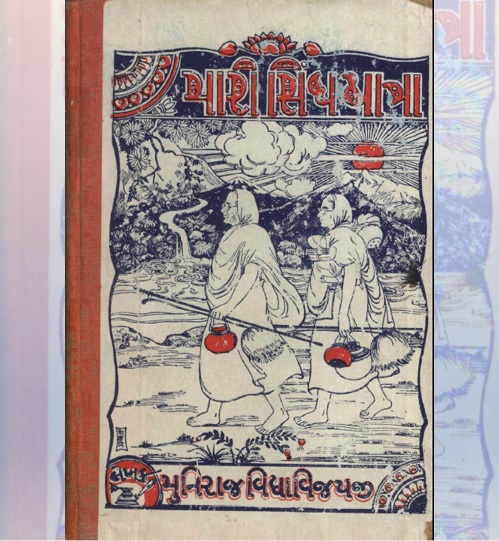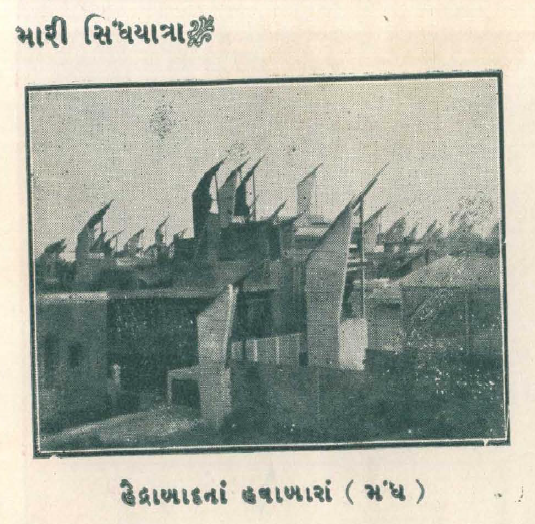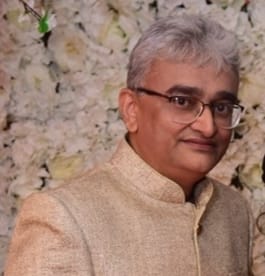
These Sindhis are very devout. Despite being non-vegetarian, they have affection towards Saints.
[Editor’s Note: This is Part 14 (Hyderabad) of a series of articles based on a pre-partition book named “મારી સિંધ યાત્રા” (“منهنجي سنڌ جو سفر”) in Gujarati authored by Jain sadhu Shri Vidyavijayji, narrating his experiences of travel and stay in Karachi for about 2 and half a years between 1937 and 1939. It would be advisable to click on the Introductory Article and read it for a better understanding of the series. – Nasir Aijaz, Editor Sindh Courier]
Vimal Shah, Mumbai
Hyderabad
In the entire Sindh region, Hyderabad has its unique position. Once known as Nairunkot is now Hyderabad. Gulam Shah rebuilt the fort of Nairunkot in 1768 and established this city. The capital of Gulam Shah was Khudabad. He changed the capital to this new city Hyderabad established by him. Many Hindus migrated from Khudabad and settled in Hyderabad. Hyderabad progressed much during the period of Mirs. The population of Hyderabad is about one lakh twenty-five thousand. Needless to mention that Hyderabad being the capital city and ruled by Muslim rulers for hundreds of years, the city is largely populated by Muslims.
The Scenes of the City
The unique feature of the city is related to the construction of the houses. The Havelis of Hindus are tall touching the skies. For quick circulation of air from the top to the bottom floors, ventilator grills are fixed on the housetops.
The Wind-catchers of Hyderabad – ‘Mangh’

Two small walls are built in the East and South, giving a passage for the breezes coming from the North and West to enter the buildings. Since all the buildings are equipped with such wind-catchers on housetops, they look a little weird from a distance. These wind-catchers are called ‘Mangh’ in Sindhi. Other villages in Sindh have begun to copy this design of Mangh. Therefore, villages too have houses with such Mangh. Hyderabad is built on small hills. The city looks beautiful with nice roads and rows of buildings. This city of Sindh is fortunate to have the ‘Fuleri’ (Fuleli) river flowing nearby. The Ghats and the trees on its banks add to the beauty of the river. Hundreds of devotees enjoy bathing and darshan at the riverbank early morning.
The Sindhi Hindus
There are mainly two communities among the Sindhi Hindus in Hyderabad – ‘Amil’ and ‘Bhaiband’. The Amils live in Karachi and other places and the Amils of Hyderabad are known as Hyderabadis. These Amils are mostly Jamindars, or they are in employment. These Hyderabadi Amils also hold positions like Collectors and Commissioners. The Bhaibands are mostly traders.
The Sindhi Hindus – Amils and Bhaiband are significantly influenced by the modern education.
The Sindhi Hindus – Amils and Bhaiband both consume a lot of meat and wine. They are significantly influenced by the modern education. They possess a lot of wealth, are posted in big positions, travel a lot to foreign countries, and since they are under Muslim rulers, their customs and eating habits are almost like Muslim culture. Their attire is European, and the ladies’ attire is of so latest fashion that it would beat even Parsi and Bengali ladies and still, they introduce themselves as Hindus. Not only do they introduce, but also take pride in being staunch Hindu.
The Faith of the Sindhi People
These Sindhis are very devout. Despite being non-vegetarian, they have affection towards Saints. Despite being involved in fun and luxury, they have the urge to listen to sermons. If they come to know that some learned Saint has come, they will gather in large numbers. If the Sindhi Hindus get cohabited with true preachers, the community can make a lot of spiritual progress.
The days were too hot. Habitual of luxuries, the Sindhis cannot venture out before evenings
Our stay at Hyderabad was for a very few days, not more than a week. The days were too hot. Habitual of luxuries, the Sindhis cannot venture out before evenings. The heat of Hyderabad is considered phenomenal in Sindh. Even in such circumstances, the Sindhis with whom we got acquainted showed a lot of devotion. Our hearts were influenced by their inquisitiveness and true faith. A few families got so attached to us that later they kept visiting Karachi for listening to our sermons.
The Eminent Personalities
Hyderabad is an elegant city. It is obvious that in such a city there would be many generous, respectable, scholarly, and famous personalities. But since our stay was very limited, we could not get acquainted with many people. The people with whom we got acquainted and we found specialities in their life were two dignitaries. One of them is Sadhu Vaswani and the other is Behan Parvati C. Advani.
Sadhu Vaswani
He is one of the many dignitaries of not only Hyderabad or Sindh but the entire Hindustan. Rather he is one of the world-famous personalities. Many Sindhis worship ‘Sadhu Vaswani’ like a Sadhu. His austerity and compassion are exceptional. His personality influences others. Bhai Indulal Gandhi writes in his article titled ‘Aspashta Darshan’ – ‘As soon as you talk of Sindhi Literature and Culture, the image of courteous Sadhu Vaswani comes in front of your eyes. He is in the first row of the leaders keeping the flow of Aaryan Culture alive in Sindh.
He has propagated non-violence amongst the non-vegetarian Sindhis. Devoted ladies and gentlemen happily get together to listen to his early morning discourses. His books in English are respectfully read in Europe and America as well. He holds a lot of respect for Bhagwan Mahavir. He is a big admirer of Gurudev Shri Vijay Dharmasuri Maharaj. Everyone was joyful when we met in Hyderabad. He promised to extend all kinds of cooperation in propagating compassion in Sindh. We had a lot of deliberation for writing ‘Mahavir Charitra’ in English. He also came to Karachi, but due to certain unavoidable circumstances, it did not materialize.
Behen Parvati
The family of Deewan Lalchand Advani in Hyderabad is cultured, educated, wealthy, and dedicated to religion. Behen (Sister) Parvati is a cultured, humble, and devoted lady of this family. Sindhis are normally connected with the Persian language. Seldom anyone would opt for Sanskrit. Behen Parvati is a graduate and a scholar of Sanskrit. Her entire family is very devout and religious. They consider serving Sadhus the best of fortunes.
Behen Parvati is a graduate and a scholar of Sanskrit. Her entire family is very devout and religious. She has translated five of my books in Sindhi.
The entire family of Behen Parvati served us very well during our stay in Hyderabad. Not only that but later they used to keep visiting Karachi for listening to sermons. Behen Parvati is a staunch vegetarian. She has translated five of my books in Sindhi which are published, and they have been widely circulated throughout Sindh. Behen Parvati deserves a large part of the credit for the results obtained with the propaganda of these books among the non-vegetarian Sindhis. She aims to gain knowledge about the Jain religion and follow the teachings as far as possible. Her innocent devout can be surely distinguished from other Sindhis. She gave lectures in English on the anniversaries of Gurudev Shri Vijay Dharmasuri Maharaj and entertained people with her abilities in music from time to time. She and her family had served well even during my illness. She has also written a biography of Gurudev Shri Vijay Dharmasuri and a short biography named “Lord Mahavir” in Sindhi. Taking inspiration from her and her entire family, many Sindhi families in Hyderabad and Karachi got the advantage of listening to sermons and becoming vegetarian. The prominent families among them are Mukhi Dingomal and Putalimai, etc. from Hyderabad, and Govind Mirchandani, Deewan Jivatram Advani, Deewan Jhamatmalji, Dr. Gidwani, etc. from Karachi.
There are many Sindhis who can make a lot of spiritual progress, given the right guidance. Any amount of water poured on a baked pot will go to waste, whereas such innocent and detached souls will absorb a lot from a little sermon. The other brothers and sisters of Behen Parvati are also gentle and devoted. And her old age mother is like a deity in her family.
Population of Jains
There are about twenty-five families of Jain community in Hyderabad. The prominent amongst them are Sheth Vanechand bhai ‘Kaka’ (who expired recently), Sheth Sakarchand bhai, Bhai Himmatlal and Keshavlal, etc. Except for one or two, the rest all follow the ‘Sthanakwasi’ sect, but their devotion, devout and courtesy towards us were appreciable. During our stay at Hyderabad, hundreds of ladies and gentlemen came from Karachi. They had been very welcoming hosts for all of them.
The Gujarati Community
Though the population of Gujaratis is not significant in Hyderabad, still it is in good numbers. Dr. Bhatt Saheb, Engineer Dave Saheb, and Engineer Maganlal Shah are prominent among them. Very recently a ‘Gujrati Samaj’ has been established in Hyderabad and it is doing some social work. As seen everywhere, despite being established very recently, the stories of enmity among people that come out are painful.
The Places of Interest
The list of prominent Places of Interest includes – the Gigantic Railway Bridge near the city, the Fort of the Mirs period, and the Kirti Stambh of Devdi. And if you want to add more – the Lunatic Asylum of Giddu Bandar too may be considered. (Continues)
Click here for Part-I, Part-II, Part-III, Part-IV, Part-V , Part-VI , Part-VII , Part-VIII , Part-IX, Part-X, Part-XI, Part-XII, Part-XIII
____________
About the contributor of the series of Articles based on the book
 Vimal Shah is a follower of Jainism by birth and is based in Mumbai, India. He is a Computer Engineer and holds a Diploma in Jainology from Mumbai University. He has an immense interest in reading, writing, studying, and teaching Jain Philosophical subjects. He conducts classroom as well as online sessions on Jain Philosophical courses. He continues to study various subjects and remains a student of Jain Philosophy. He has significantly contributed to the Translation Project of the ‘Compendium of Jainism’ from English to Gujarati – an initiative of the JAINA India Foundation. He is also associated with a Project for the translation of Jain Aagams (Scriptures) from Gujarati to English. He has a special interest in the history and preservation of the Jain Heritage in Pakistan. He was part of a Delegation of the Jain Heritage Foundation, New Delhi that visited various Jain Heritage Sites in Pakistan in May-2023.
Vimal Shah is a follower of Jainism by birth and is based in Mumbai, India. He is a Computer Engineer and holds a Diploma in Jainology from Mumbai University. He has an immense interest in reading, writing, studying, and teaching Jain Philosophical subjects. He conducts classroom as well as online sessions on Jain Philosophical courses. He continues to study various subjects and remains a student of Jain Philosophy. He has significantly contributed to the Translation Project of the ‘Compendium of Jainism’ from English to Gujarati – an initiative of the JAINA India Foundation. He is also associated with a Project for the translation of Jain Aagams (Scriptures) from Gujarati to English. He has a special interest in the history and preservation of the Jain Heritage in Pakistan. He was part of a Delegation of the Jain Heritage Foundation, New Delhi that visited various Jain Heritage Sites in Pakistan in May-2023.